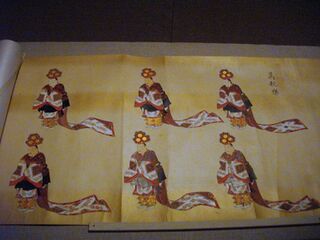Bugaku
- Japanese: 舞楽 (bugaku)
Bugaku is a classical Japanese form of Imperial court dance, closely associated with gagaku court music. It is derived from a combination of Shinto dance and Chinese, Korean, and Southeast Asian influences, and developed into its mature form largely in the 8th-9th centuries.
Like gagaku court music, which is divided into Chinese- and Korean-derived forms (Tôgaku and Komagaku), bugaku is divided into three categories: kuniburi-no-mai (native Japanese dances), Sa-no-mai (dances of the left, derived from those of the Tang Dynasty first introduced in 698), and U-no-mai (dances of the right, derived from those of Korea). The Chinese-style dances typically use red costumes, while the Korean-style ones use green costumes. Performers included both court nobles and hereditary guilds of court entertainers, and bugaku continued through to the modern era.
The Chinese-style dances are typically accompanied by three types of flutes (hichiriki, ryûteki, and shô) and percussion instruments such as the kakko, shôko, and taiko, without string instruments. The Korean-style dances, the shô and ryûteki are replaced by the Korean-style flute (komabue), and the san-no-tsuzumi instead of kakko.
Bugaku Dances
- Genjôraku 還城楽 (aka Kenjaraku 見蛇楽) is a dance of a foreigner who is dancing with happiness after catching a snake. It is not known when this dance developed. The mask for this dance is covered completely in vermillion lacquer, and features large white tufts of hair for the eyebrows, mustache, and beard.[1]
- Konju 胡飲酒 (aka Suigoraku 酸胡楽, Eninraku 宴飲楽, Inshuraku 飲酒楽) is a dance based on or inspired by foreigners dancing drunkenly. This dance was performed by members of the Ô family (多家) since ancient times, but around 1100, Ô no Suketada was killed by Yamamura Masatsura, and the performance of this dance was suspended for a time. The mask for this dance is a dark red, with large eyes and long black hair.[1]
- Nasori 納曽利 is an u-no-mai (Korean-style) dance associated with the gagaku piece Ryôô 陵王. The details are somewhat unclear, but it is generally said to be a dance of two dragons (male and female). When performed by just one dancer, it is called Rakuson 落蹲. The masks are blue with large white eyes rimmed in red. Large tusks curve upwards out of the upper jaw of the mask, and fangs from the lower jaw, which hangs slackenly from the main portion of the mask, which also features numerous tufts of hair.[1]
- Ryôô 陵王 is a representative dance of the Sa-no-mai (Chinese-style) fast-paced "running dances" (hashirimono). The dragon-like mask is said to be based on or inspired by that of Gāo Chánggōng, Prince of Lánlíng (J: Ranryôô, hence the name of the piece), a high-ranking general of the Northern Qi Dynasty who, it is said, had such a beautiful face that he needed to cover it with a frightening mask in order to be successfully fearsome and intimidating on the battlefield. The dance itself is said to be based on, or inspired by, one he performed after defeating a great Northern Zhou army. The mask for this dance is rather complex and is perhaps the most complicated of all bugaku masks to reproduce. It features a gilded face with blue forehead and small dragon-like figures with multicolored wings on the top and sides; white tufts of hair extend from the eyebrows, mustache, and beard of the mask, the lower jaw of which hangs freely on strings below the main portion of the mask. Roughly five styles of Ryôô masks are standard: an imperial court style, a Fujiwara style, a Heike style, and a Genji style transmitted as tradition since the classical era, and a Tokugawa style developed in the early modern period.[1]
References
- Gallery labels, Tokyo Imperial Palace.[6]
- Gallery label, "Bugaku Scroll," Metropolitan Museum of Art, 57.52.1.[7]

